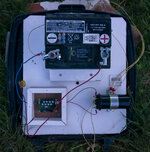SG61-addict
Junior Member level 1
Hello,
I'm trying to install an electric fence in my garden to protect my vegetables and trees against boars, deer and other wild game. To be effective I have to put 5 wires from 20cm to 1.5m from the soil and be quite generous with the energy discharge. I will probably build a separate circuit to drive the lower wire, I don't want to kill or over stress the neighbor's cat
Basically, a lot of peoples do it with a 12V battery, a car ignition coil and a power transistor driven by a 555 or any pulse generator. The circuits I've found on the web are really old and often use ugly NPN darlington...

In theses designs, there is a big spike at the MOS drain caused by the coil at the opening at the MOS. They try to dump it:
- Adding D2 => works fine but also dump the hv pulse so the whole design is useless
- Adding D3 and/or D4 => in simulation, this have absolutely no effect
- Doing nothing and changing the switching device when dead
When simulating this design with no diodes but a real NMOS model, the Vdrain peak voltage is approximately 10-50V higher than the max Vds voltage specified in the datasheet.
What will be the good protection device if I want to use a NMOS device ?
Some rare designs are using a capacitor in series with the primary coil. The capacitor is initially charged to a medium voltage (100-300V) and then it is shorted across the coil. This more complex design looks to be less RF-noisy and less aggressive for the switching device. The medium-level voltage can be easily generated with a little coilcraft transformer (e.g. DA2032, ...).

In simulation, this works fine with some particularities :
- Compared to the basic schematic, the output energy is much lower when output load decrease
- The primary coil of a car ignition coil is intended to be driven by a 12V signal, not 100V. The output voltage with no load is enormous. The coil insulation may be insufficient.
- Since the energy came from a LC resonant tank, the output waveform is a sine. But ok, a deer will probably not see the difference.
I really would like to build something strong and robust. Not afraid by complex electronics and modern packages.
Professional generators are really expensive. Affordable ones are either not powerful, not robust or I can probably build them for 1/10th of the price.
Any advice will be strongly appreciated
Many thanks
I'm trying to install an electric fence in my garden to protect my vegetables and trees against boars, deer and other wild game. To be effective I have to put 5 wires from 20cm to 1.5m from the soil and be quite generous with the energy discharge. I will probably build a separate circuit to drive the lower wire, I don't want to kill or over stress the neighbor's cat
Basically, a lot of peoples do it with a 12V battery, a car ignition coil and a power transistor driven by a 555 or any pulse generator. The circuits I've found on the web are really old and often use ugly NPN darlington...
In theses designs, there is a big spike at the MOS drain caused by the coil at the opening at the MOS. They try to dump it:
- Adding D2 => works fine but also dump the hv pulse so the whole design is useless
- Adding D3 and/or D4 => in simulation, this have absolutely no effect
- Doing nothing and changing the switching device when dead
When simulating this design with no diodes but a real NMOS model, the Vdrain peak voltage is approximately 10-50V higher than the max Vds voltage specified in the datasheet.
What will be the good protection device if I want to use a NMOS device ?
Some rare designs are using a capacitor in series with the primary coil. The capacitor is initially charged to a medium voltage (100-300V) and then it is shorted across the coil. This more complex design looks to be less RF-noisy and less aggressive for the switching device. The medium-level voltage can be easily generated with a little coilcraft transformer (e.g. DA2032, ...).
In simulation, this works fine with some particularities :
- Compared to the basic schematic, the output energy is much lower when output load decrease
- The primary coil of a car ignition coil is intended to be driven by a 12V signal, not 100V. The output voltage with no load is enormous. The coil insulation may be insufficient.
- Since the energy came from a LC resonant tank, the output waveform is a sine. But ok, a deer will probably not see the difference.
I really would like to build something strong and robust. Not afraid by complex electronics and modern packages.
Professional generators are really expensive. Affordable ones are either not powerful, not robust or I can probably build them for 1/10th of the price.
Any advice will be strongly appreciated
Many thanks
